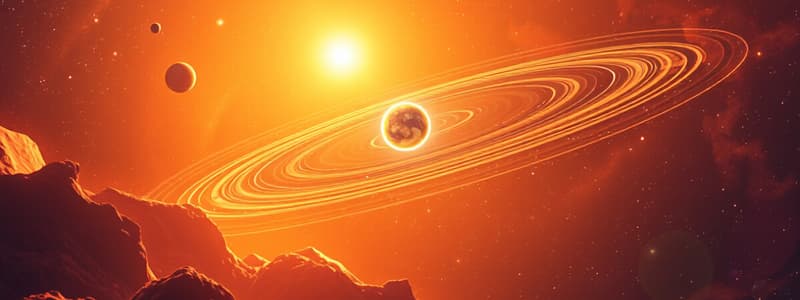Podcast
Questions and Answers
What is the definition of the term that describes the one closer to the sun?
What is the definition of the term that describes the one closer to the sun?
The one closer to the sun.
Where is Polaris located according to James's observation?
Where is Polaris located according to James's observation?
The red dot furthest away from Earth (top of the image).
Match the events in the giant impact theory to the correct order:
Match the events in the giant impact theory to the correct order:
A Mars-sized planetesimal collides with Earth. = 1 Molten material is ejected from Earth. = 2 Material accretes to form the Moon. = 3 The Moon begins rotating and revolving around Earth. = 4
The planets [] and Neptune are known as the [].
The planets [] and Neptune are known as the [].
Which planet has a relatively thick atmosphere that traps heat?
Which planet has a relatively thick atmosphere that traps heat?
Match the attributes to the appropriate planet:
Match the attributes to the appropriate planet:
What indicates that an object is not a planet?
What indicates that an object is not a planet?
Why can water exist as a solid, liquid, or gas on Earth?
Why can water exist as a solid, liquid, or gas on Earth?
What is the value of the constant k in Kepler's third law for Mars?
What is the value of the constant k in Kepler's third law for Mars?
Which two pieces of data indicate Jupiter's outer solar system location?
Which two pieces of data indicate Jupiter's outer solar system location?
Which feature indicates that Mars is in the inner solar system?
Which feature indicates that Mars is in the inner solar system?
What signifies that a distant star is part of a planetary system?
What signifies that a distant star is part of a planetary system?
What statement describes a similarity between Earth and Venus?
What statement describes a similarity between Earth and Venus?
Match each star with the correct element based on absorption wavelengths: Star 1 is [], Star 2 is [], and Star 3 is [____].
Match each star with the correct element based on absorption wavelengths: Star 1 is [], Star 2 is [], and Star 3 is [____].
The distance between Earth and Mars is 225 million km. When converted using the conversion factor 1 AU = 1.5 × 10^8 km, the distance between the planets is ______.
The distance between Earth and Mars is 225 million km. When converted using the conversion factor 1 AU = 1.5 × 10^8 km, the distance between the planets is ______.
The astronomical unit (AU) is ______ a light-year.
The astronomical unit (AU) is ______ a light-year.
What is the movement of the spectral lines if they shift from 400 nm to 430 nm?
What is the movement of the spectral lines if they shift from 400 nm to 430 nm?
What is the movement of the spectral lines if they shift from 610 nm to 580 nm?
What is the movement of the spectral lines if they shift from 610 nm to 580 nm?
Match the tools with the advantages they offer to astronomers:
Match the tools with the advantages they offer to astronomers:
In which sequence did the events of the big bang occur?
In which sequence did the events of the big bang occur?
Which occurrence would contradict the big bang theory?
Which occurrence would contradict the big bang theory?
Which observational tool helped astronomers Arno Penzias and Robert Wilson discover the existence of the cosmic microwave background (CMB)?
Which observational tool helped astronomers Arno Penzias and Robert Wilson discover the existence of the cosmic microwave background (CMB)?
Which occurrence would contradict the big bang theory?
Which occurrence would contradict the big bang theory?
Venus is an average distance of 108.2 million kilometers from the Sun. Use the conversion factor 1 AU = 1.5 × 10^8 km to convert this distance from kilometers to astronomical units. Choose the closest answer.
Venus is an average distance of 108.2 million kilometers from the Sun. Use the conversion factor 1 AU = 1.5 × 10^8 km to convert this distance from kilometers to astronomical units. Choose the closest answer.
How do dying stars contribute to the formation of planets?
How do dying stars contribute to the formation of planets?
The temperature of a star is 6000K and its luminosity is 1000. Which type of star is it?
The temperature of a star is 6000K and its luminosity is 1000. Which type of star is it?
Which statement about nuclear fusion is correct?
Which statement about nuclear fusion is correct?
Which condition in a nebula would prevent nuclear fusion?
Which condition in a nebula would prevent nuclear fusion?
Determine which physical conditions are necessary to support nuclear fusion and formation of stars and put them in one category: Promotes Stellar Formation or Does Not Promote Stellar Formation.
Determine which physical conditions are necessary to support nuclear fusion and formation of stars and put them in one category: Promotes Stellar Formation or Does Not Promote Stellar Formation.
Use the Hertzsprung-Russell diagram to determine which condition describes each star.
Use the Hertzsprung-Russell diagram to determine which condition describes each star.
Arrange the events involved in nuclear fusion in the correct order.
Arrange the events involved in nuclear fusion in the correct order.
Identify the phases in the life cycle of small and big stars.
Identify the phases in the life cycle of small and big stars.
The table shows chronological events in the life of our Sun. Place the missing events into the correct rows of the table.
The table shows chronological events in the life of our Sun. Place the missing events into the correct rows of the table.
Classify the planets based on their composition.
Classify the planets based on their composition.
What picture does the term refer to?
What picture does the term refer to?
Arrange the events leading up to the formation of a solar system.
Arrange the events leading up to the formation of a solar system.
Match each orbiting body to its attribute.
Match each orbiting body to its attribute.
According to one theory, Earth's moon accreted to form its current structure following a giant impact between Earth and another celestial body. Complete the paragraph to describe the process of accretion. The debris was held close to Earth by Earth's ______.
According to one theory, Earth's moon accreted to form its current structure following a giant impact between Earth and another celestial body. Complete the paragraph to describe the process of accretion. The debris was held close to Earth by Earth's ______.
James observes an orbiting body that is approximately 5.2 AU away from the Sun. He knows that it is primarily composed of helium and hydrogen. In which region of the solar system is the orbiting body located?
James observes an orbiting body that is approximately 5.2 AU away from the Sun. He knows that it is primarily composed of helium and hydrogen. In which region of the solar system is the orbiting body located?
In the diagram, planets A, B, and C have the same mass. Which of these statements is true about the motion of these planets?
In the diagram, planets A, B, and C have the same mass. Which of these statements is true about the motion of these planets?
How would the absence of gravity affect the formation of planets?
How would the absence of gravity affect the formation of planets?
Which two statements about the disk-shaped nebula are true?
Which two statements about the disk-shaped nebula are true?
What are two reasons why the terrestrial planets formed closer to the Sun after the supernova event that initiated the formation of the solar system?
What are two reasons why the terrestrial planets formed closer to the Sun after the supernova event that initiated the formation of the solar system?
An observer on the Moon sees a solar eclipse. What does an observer on Earth see?
An observer on the Moon sees a solar eclipse. What does an observer on Earth see?
Earth's axis is tilted to one side. Which phenomenon would cease to exist in the absence of this axial tilt?
Earth's axis is tilted to one side. Which phenomenon would cease to exist in the absence of this axial tilt?
Which statement could be a direct outcome of the formation of the Moon according to the giant impact theory?
Which statement could be a direct outcome of the formation of the Moon according to the giant impact theory?
Which statement supports the giant impact theory for the formation of the Moon?
Which statement supports the giant impact theory for the formation of the Moon?
Why do areas north of the Arctic Circle in the Northern Hemisphere experience a polar day lasting for several months during summer?
Why do areas north of the Arctic Circle in the Northern Hemisphere experience a polar day lasting for several months during summer?
Select the correct answer from each drop-down menu. Tides on Earth are caused by the combined effect of the Sun and the Moon. However, the Moon has a ______ effect on tides than the Sun because the Moon is ______ to Earth.
Select the correct answer from each drop-down menu. Tides on Earth are caused by the combined effect of the Sun and the Moon. However, the Moon has a ______ effect on tides than the Sun because the Moon is ______ to Earth.
Flashcards are hidden until you start studying
Study Notes
Distance and Units
- Distance from Earth to Mars is approximately 225 million km.
- 1 AU (Astronomical Unit) equals 1.5 × 10^8 km.
- Mars is 1.5 AU from Earth, indicating this distance is longer than 1 AU.
Spectral Analysis
- Spectral shifts in light can indicate the movement of celestial objects.
- Objects moving toward Earth experience blue shifts, while those moving away show red shifts.
- Example shifts:
- 610 nm to 580 nm and 512 nm to 480 nm indicate movement toward Earth.
- 400 nm to 430 nm and 670 nm to 690 nm indicate movement away from Earth.
Astronomical Tools
- Space telescopes capture images from outside Earth's atmosphere.
- Optical telescopes provide magnified views of celestial objects.
- Radio telescopes detect radio waves outside the visible spectrum.
- Photography allows sharing of celestial images for scientific comparison.
Big Bang Sequence
- The universe originated from a singular point and expanded.
- Key events include forming atomic nuclei, hydrogen fusing into helium, and creating neutral atoms.
Cosmic Microwave Background
- The cosmic microwave background (CMB) was discovered using radio telescopes.
- A fundamental prediction of the big bang theory is distant galaxies moving away from Earth.
Stellar Life Cycle
- Dying stars produce heavy elements like iron and gold through supernova explosions.
- Star classification can include stages such as main sequence, giant, supergiant, and white dwarf.
Nuclear Fusion
- Nuclear fusion in stars typically involves hydrogen nuclei fusing to form helium.
- Conditions promoting fusion include high temperature and increased gravitational attraction.
Formation of Solar Systems
- A solar system forms from a rotating nebula that flattens and shrinks, leading to nuclear fusion.
- Terrestrial planets are denser and form closer to the Sun due to higher temperatures.
Planet Composition
- Terrestrial planets include Mercury, Venus, Earth, and Mars due to their solid composition.
- Gas giants are primarily composed of hydrogen and helium, such as Jupiter and Saturn.
- Ice giants like Uranus and Neptune have a unique composition distinct from gas giants.
Tides and Gravity
- Tides on Earth are influenced more by the Moon than the Sun due to proximity.
- Absence of gravity would prevent the accretion of rocks and debris into planets.
Earth-Moon Relationship
- The Moon's formation aligns with the giant impact theory, suggesting an early collision with a Mars-sized body.
- Earth's axial tilt leads to seasonal changes and affects phenomena such as solstices.
Observational Phenomena
- The view of solar and lunar eclipses differs based on the observer's location (Earth vs. Moon).
- Observations of celestial bodies like Polaris provide insights into Earth's axial rotation.
Summary of Key Concepts
- Understanding celestial mechanics requires knowledge of forces, distances, and the life cycles of stars.
- Utilizing telescopes and various observational tools helps gather data on the universe.
- The formation and evolution of planetary systems implicate crucial astrophysical processes and historical events.### Venus and Neptune Characteristics
- Venus has a thick atmosphere that traps heat, contributing to its status as the hottest planet.
- Venus experiences retrograde rotation, spinning clockwise when viewed from above.
- Neptune features visible bands, clouds, and rings in its atmosphere.
- Neptune has 13 known moons, with Triton being the largest.
Planet Attributes
- Earth is recognized as the densest planet in the solar system.
- Venus is identified as the hottest planet due to its greenhouse gas effects.
- Jupiter holds the title of the largest planet in the solar system.
- Mercury is known as the smallest planet in the solar system.
Planet vs. Non-Planet Objects
- Objects that orbit the Sun are classified as planets if their surrounding regions are free from debris.
- Satellites, such as moons, fall under non-planet classifications and can have different shapes, like triangular.
Earth's Water States
- Earth can sustain water in solid, liquid, and gas states due to its ideal temperature, related to its distance from the Sun.
Kepler's Third Law
- Kepler's third law relates the orbital period (P) to the semimajor axis (A) of an orbiting body through the equation P² = kA³.
- For Mars, with a semimajor axis of 1.52 AU and an orbital period of 687 days, the constant k is calculated as 1.34 × 10⁵.
Jupiter's Characteristics
- Jupiter's composition primarily consists of hydrogen and helium.
- It features colorful bands formed by its gaseous surface, indicating its location in the outer region of the solar system.
Mars and the Inner Solar System
- Mars is characterized by its rocky surface, suggesting a solid terrain suitable for standing, indicating its position in the inner solar system.
Astronomical Indicators
- A star is deemed part of a planetary system if it exhibits periodic dimming, which can indicate transiting planets.
Similarities Between Earth and Venus
- Both Earth and Venus showcase evidence of volcanic activity, an important geological feature.
Stellar Element Identification
- Stars can have their compositions determined through the absorption wavelengths of light:
- Star 1 contains Helium.
- Star 2 has Sulfur.
- Star 3 features Carbon.
Studying That Suits You
Use AI to generate personalized quizzes and flashcards to suit your learning preferences.





